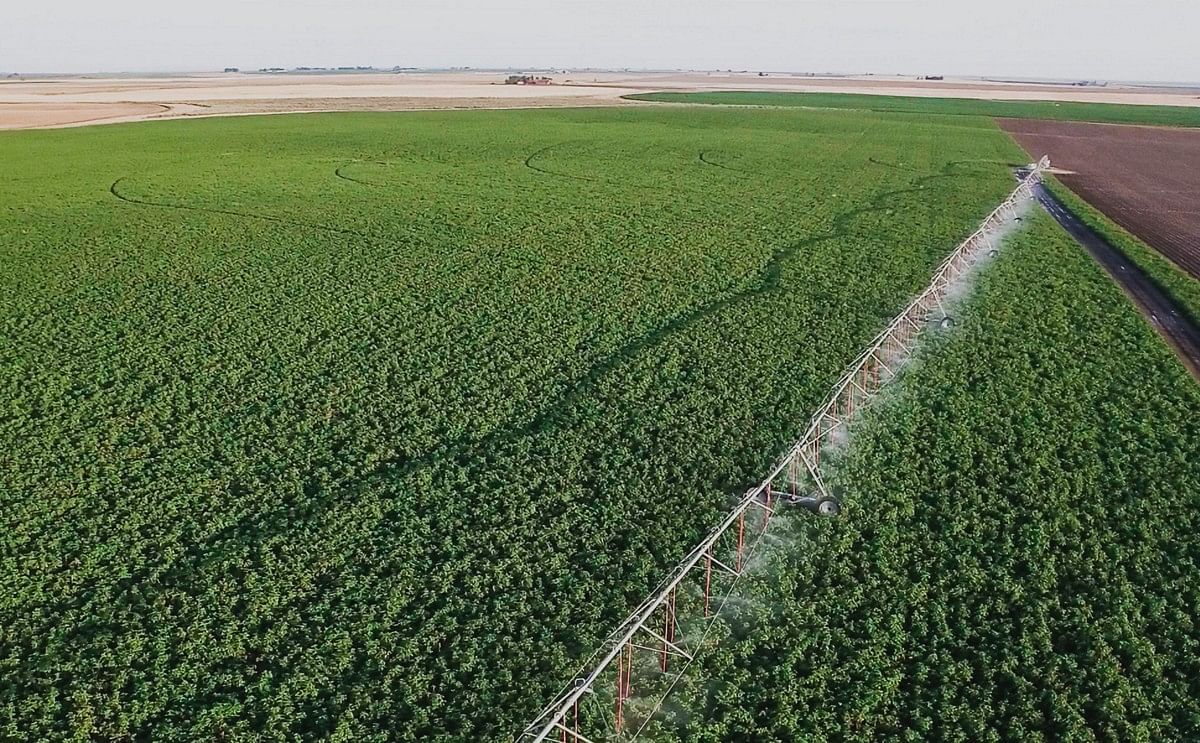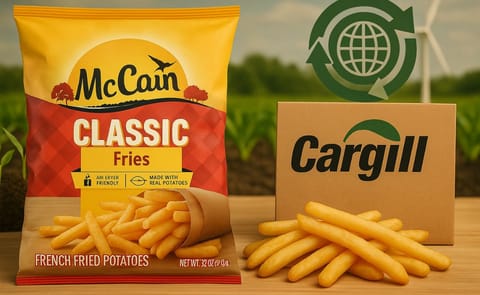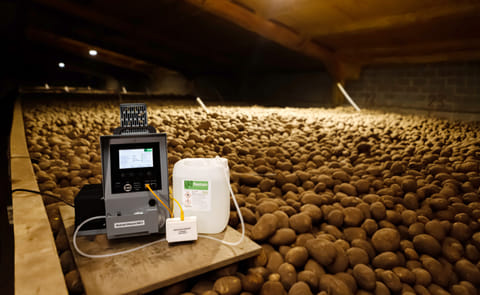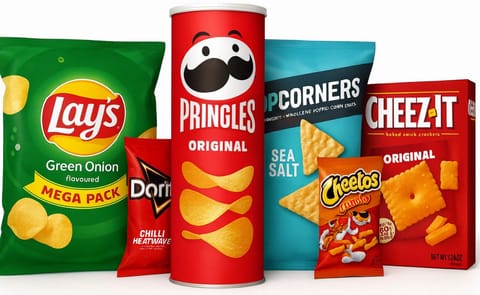Lamb Weston Reports Fiscal Fourth Quarter and Full Year 2021 Results; Provides Fiscal Year 2022 Outlook
Lamb Weston Reports Fiscal Fourth Quarter and Full Year 2021 Results; Provides Fiscal Year 2022 Outlook

Fourth Quarter Fiscal 2021 Highlights
- Net sales increased 19% to 1,008 million
- Income from operations increased 220% to $99 million
- Net income increased to $66 million from a loss of $2 million
- Diluted EPS increased to $0.44 from a loss of $0.01
- Adjusted EBITDA including unconsolidated joint ventures(1) increased 112% to $166 million
Full Year 2021 Highlights
- Net sales declined 3% to 3,671 million
- Income from operations declined 15% to $475 million
- Net income declined 13% to $318 million
- Diluted EPS declined 13% to $2.16
- Adjusted EBITDA including unconsolidated joint ventures(1) declined 6% to $748 million
- Cash flows from operations declined 4% t $553 million
- Returned $161 million of cash to stockholders in the form of both dividends and share repurchases
Fiscal 2022 Outlook
- Net sales growth above long-term target range of low-to-mid single digits
- Net income and Adjusted EBITDA including joint ventures(1) to be pressured during the first half, and normalize in the second half
Lamb Weston Holdings, Inc. (NYSE: LW) announced today its fiscal fourth quarter and full year 2021 results and provided its outlook for fiscal 2022.
Tom Werner, President and CEO:
"Fiscal 2021 was the most challenging operating environment in our company’s history, but we believe the worst of the COVID-19 pandemic’s effect on our business is behind us."
"I’m proud of how the entire Lamb Weston team has been navigating through the pandemic by prioritizing the health and welfare of our employees, maintaining product safety, and servicing our customers."
"We’re encouraged by the pace of recovery in U.S. restaurant traffic, especially at full-service restaurants, and continue to expect that overall U.S. french fry demand will return to pre-pandemic levels around the end of calendar 2021."
"We also anticipate that demand in Europe and in our key export markets will steadily improve as vaccines become more widely available and vaccination rates increase in those markets."
"While french fry demand trends have become more predictable compared to a year ago, the lingering effects of the pandemic and the sharp recovery of the broader economy in the U.S. has disrupted supply chain operations across all industries, including ours."
"While we expect these disruptions to be transitory, we believe these challenges, along with notable input and transportation cost inflation and the impact of a tighter labor market, will continue to pressure our earnings in the near term."
"However, we expect these pressures will ease as we anticipate gradual improvements in our supply chain operations as global economic conditions continue to stabilize, and as we look to pass through rising costs."
"Having seen the resiliency of french fry demand during the pandemic, we remain confident in the long-term health and growth prospects for the global category, and are committed to supporting this growth and our customers by investing in new capacity."
"Along with driving margin improvement by improving product and customer mix, pricing to offset inflation, and executing on our lean manufacturing initiatives, we believe we’re well-positioned to drive sustainable, profitable growth and create value for our stakeholders over the long term."

Summary of Fourth Quarter and FY 2021 Results ($ in millions, except per share)
Net sales increased $160.6 million to $1,007.5 million, up 19 percent versus the prior year quarter, with volume up 13 percent and price/mix up 6 percent. Net sales and volume increased 28 percent and 21 percent, respectively, excluding the benefit of the additional selling week in the prior year quarter.
The increase in sales volume predominantly reflected the recovery in demand for frozen potato products outside the home as governments further eased COVID-19 pandemic-related social restrictions, including on restaurants and other foodservice operations.
The increase in sales volume also reflected the comparison to reduced shipments in the prior year quarter when customers significantly destocked inventories as they adjusted to the abrupt change in the business environment. The increase in price/mix was driven primarily by favorable price and mix in each of the Company’s core business segments.
Income from operations increased $68.0 million to $98.9 million, up 220 percent versus the prior year quarter, reflecting higher sales and gross profit, partially offset by higher selling, general and administrative expenses (“SG&A”). Gross profit increased $86.9 million, driven by higher sales and lower manufacturing and distribution costs on a per pound basis.
The lower costs per pound largely reflected a reduction in incremental costs and inefficiencies related to the COVID-19 pandemic’s effect on the Company’s production, transportation, and warehousing operations as compared to the prior year, as well as supply chain productivity savings.
The lower costs per pound were partially offset by input and transportation cost inflation. The increase in gross profit also included a $26.7 million increase in unrealized mark-to-market adjustments associated with commodity hedging contracts, which includes an $18.8 million gain in the current quarter, compared with a $7.9 million loss related to these items in the prior year quarter.
SG&A increased $18.9 million compared to the prior year quarter, largely due to higher incentive compensation accruals and investments to improve the Company’s manufacturing, supply chain, and commercial operations over the long term.
In addition, advertising and promotional expense (“A&P”) increased $3.1 million, largely in support of the launch of new products in the Retail segment. The increase in SG&A was partially offset by cost management efforts.
Net income was $65.5 million, up $67.1 million versus the prior year quarter, and Diluted EPS was $0.44, up $0.45 versus the prior year quarter, driven by an increase in income from operations and equity method investment earnings.
Adjusted EBITDA including unconsolidated joint ventures(1) increased $88.0 million to $166.3 million, up 112 percent versus the prior year quarter, driven by higher income from operations and equity method investment earnings.
The Company’s effective tax rate(2) in the fourth quarter fiscal 2021 was 17.9 percent, versus a 63.6 percent benefit in the prior year period, and the difference is primarily due to lower earnings in the fourth quarter fiscal 2020.
The Company’s effective tax rate varies from the U.S. statutory tax rate of 21 percent principally due to the impact of U.S. state taxes, foreign taxes, permanent differences, and discrete items.
Q4 2021 Segment Highlights
Global

Global Segment Summary
Net sales and volume increased 28 percent and 24 percent, respectively, excluding the benefit of the additional selling week in the prior year quarter. The recovery in demand, especially at QSRs and other large chain restaurant customers in the U.S., largely drove the increase in sales volume.
Shipments to customers in the Company’s key international markets also improved in the aggregate, although varied by country. Overall sales volume growth also reflected a comparison to reduced shipments in the prior year quarter as customers destocked inventories. The increase in price/mix reflected both favorable price and mix.
Global segment product contribution margin increased $22.9 million to $56.4 million, up 68 percent versus the prior year quarter. Higher sales volume, favorable price/mix and lower manufacturing and distribution costs per pound drove the increase.
Foodservice

Foodservice Segment Summary
Net sales and volume increased 94 percent and 74 percent, respectively, excluding the benefit of the additional selling week in the prior year quarter. The recovery in demand at small and regional chain restaurants, as well as independently-owned restaurants, especially at full-service establishments, drove the increase in sales volume.
Shipments to non-commercial customers, such as lodging and hospitality, healthcare, schools and universities, sports and entertainment, and workplace environments, also increased versus the prior year quarter, but remained well below pre-pandemic levels. Overall sales volume growth also reflected a comparison to reduced shipments in the prior year quarter as customers significantly destocked inventories.
In the current quarter, shipment and order trends in each of the segment’s primary sales channels improved as the quarter progressed as governments eased social restrictions, and as consumers enjoyed the onset of warmer weather. The increase in price/mix largely reflected the benefit of favorable mix from higher sales of Lamb Weston branded and premium products, which had softened in the prior year quarter.
Foodservice segment product contribution margin increased $53.8 million to $96.3 million, up 127 percent compared to the prior year quarter. Higher sales volume, favorable price/mix and lower manufacturing and distribution costs per pound drove the increase.
Retail

Retail Segment Summary
Net sales and volume declined 22 percent and 24 percent, respectively, excluding the benefit of the additional selling week in the prior year quarter.
The sales volume decline reflects a comparison to the prior year quarter that included a surge in demand for in-home consumption of frozen potato products following government-imposed social restrictions, as well as lower shipments of private label products resulting from incremental losses of certain low-margin business.
However, total shipments in the current quarter remained near pre-pandemic levels, driven by continued strong demand for the Company’s premium and mainstream branded offerings, partially offset by lower private label sales. The increase in price/mix was largely driven by favorable mix from higher sales of branded products.
Retail segment product contribution margin declined $10.2 million to $21.2 million, down 32 percent versus the prior year quarter. Lower sales volumes and a $3.1 million increase in A&P expenses to support new product launches, drove the decline, partially offset by favorable price/mix.
Equity Method Investment Earnings
Equity method investment earnings (loss) from unconsolidated joint ventures in Europe, the U.S., and South America were earnings of $9.6 million and a loss of $6.1 million for the fourth quarter of fiscal 2021 and 2020, respectively.
Equity method investment earnings (loss) included a $4.5 million unrealized gain related to mark-to-market adjustments associated with currency and commodity hedging contracts in the current quarter, compared to a $2.7 million unrealized gain related to these items in the prior year quarter.
Excluding the mark-to-market adjustments, earnings from equity method investments increased $13.9 million compared to the prior year period. The earnings increase was driven by higher sales volume due to a recovery in demand, as well as higher incremental costs and inefficiencies related to the pandemic’s effect on operations, including the write-off of raw potato contracts, in the prior year.
Fiscal Year 2021 Commentary
Net sales declined $121.5 million to $3,670.9 million, down 3 percent versus fiscal 2020, with volume down 6 percent and price/mix up 3 percent. Net sales and volume declined 2 percent and 6 percent, respectively, excluding the benefit of the 53rd week in the prior year.
The decline in sales volume reflected soft demand for much of the first three fiscal quarters following government-imposed pandemic-related social restrictions, including on restaurants and other foodservice operations.
As described above, sales volumes increased in the fiscal fourth quarter due to a recovery in demand, as well as a comparison to reduced shipments in the prior year quarter when customers were destocking inventories. The increase in price/mix was driven primarily by favorable pricing in the Company’s Foodservice segment and favorable mix in its Retail segment, while price/mix in the Global segment was flat.
Income from operations declined $82.1 million to $474.8 million, down 15 percent from the prior year, reflecting lower gross profit and higher SG&A.
Gross profit declined $63.2 million, driven by lower sales and higher manufacturing and distribution costs on a per pound basis, which largely included: incremental costs and inefficiencies related to the pandemic’s effect on the Company’s production, transportation, and warehousing operations; and input and transportation cost inflation.
The increase in costs was partially offset by supply chain productivity savings. In addition, gross profit included a $40.4 million change in unrealized mark-to-market adjustments and realized settlements associated with commodity hedging contracts, which reflects a $37.9 million gain in the current year, compared with a $2.5 million loss related to these items in the prior year.
SG&A increased $18.9 million compared to the prior year.
The increase was largely driven by investments to improve the Company’s manufacturing, supply chain, commercial and information technology operations over the long term, which included approximately $9 million of non-recurring expenses (primarily consulting and employee training expenses) associated with implementing the first phase of a new enterprise resource planning (“ERP”) system compared to approximately $8 million in the prior year.
Additionally, the increase in SG&A was due to higher compensation and benefits. The increase in SG&A was partially offset by a $5.2 million decline in A&P expense, as well as by cost management efforts.
Net income declined $48.1 million to $317.8 million, down 13 percent versus the prior year, due to a decline in income from operations and higher interest expense, partially offset by higher equity method investment earnings.
The increase in interest expense reflected a higher level of average total debt resulting from the Company’s actions in late fiscal 2020 and early fiscal 2021 to enhance its liquidity position during the pandemic.
In addition, fiscal 2020 results included a $2.6 million ($2.0 million after-tax) loss related to the withdrawal from a multiemployer pension plan by the Company’s joint venture, Lamb-Weston/RDO Frozen (“Lamb Weston RDO”).
Diluted EPS declined $0.33 to $2.16, largely reflecting a decline in income from operations and higher interest expense, partially offset by higher equity method investment earnings.
Adjusted Diluted EPS(1), which excludes the $2.6 million loss ($2.0 million after-tax) related to the withdrawal from a multiemployer pension plan by Lamb Weston RDO in the prior year, declined $0.34 to $2.16.
Adjusted EBITDA including unconsolidated joint ventures(1) declined $51.4 million to $748.4 million, down 6 percent versus the prior year, driven by a decline in income from operations, partially offset by an increase in equity method investment earnings.
The Company’s effective tax rate(2) was 22.2 percent for fiscal 2021, compared to 23.5 percent in fiscal 2020. The difference between the Company’s effective tax rates in fiscal 2021 and 2020 is primarily due to permanent differences and discrete items.
The Company’s effective tax rate varies from the U.S. statutory tax rate of 21 percent principally due to the impact of U.S. state taxes, foreign taxes, permanent differences, and discrete items.
Fiscal Year 2021 Segment Highlights
Global

Global Segment Summary
Sales volumes in the first half of the year declined as compared to the prior year, but largely stabilized beginning in the fiscal third quarter behind strength in shipments to large QSR customers in the U.S.
As described above, overall sales volumes for the segment increased in the fiscal fourth quarter due to a recovery in demand in the U.S. and in the Company’s key international markets, as well as a comparison to reduced shipments in the prior year quarter when customers were destocking inventories. Price/mix was flat as positive pricing actions were offset by unfavorable customer mix.
Global segment product contribution margin declined $68.3 million to $306.2 million, down 18 percent compared to the prior year. Higher manufacturing and distribution costs, as well as lower sales volumes, largely drove the decline.
Foodservice

Foodservice Segment Summary
Sales volumes during the first three quarters of the year declined as compared to the prior year as demand at full-service restaurants and non-commercial customers were significantly affected by government-imposed social restrictions.
As described above, overall sales volumes for the segment increased in the fiscal fourth quarter due to a recovery in most of the segment’s customer channels, as well as a comparison to significantly reduced shipments in the prior year quarter when customers were destocking inventories.
The increase in price/mix primarily reflected the carryover benefit of pricing actions implemented during fiscal 2020, partially offset by unfavorable mix as sales of Lamb Weston branded and premium products softened during the height of the pandemic.
Foodservice segment product contribution margin declined $16.0 million to $340.0 million, down 4 percent compared to the prior year, as lower sales volumes and higher manufacturing and distribution costs more than offset the benefit of favorable price/mix.
Retail

Retail Segment Summary
The decline in sales volumes reflected lower shipments of private label products resulting from incremental losses of certain low-margin business, partially offset by strong growth in branded products, which have historically comprised approximately 40 percent of the segment’s volume.
In addition, as described above, the sales volume decline reflects a comparison to the fourth quarter of fiscal 2020 which included a surge in demand for in-home consumption of frozen potato products following government-imposed social restrictions.
Retail segment product contribution margin increased $2.6 million to $120.2 million, up 2 percent compared to fiscal 2020, as favorable product mix more than offset the impact of higher manufacturing and distribution costs, as well as lower sales volumes of private label products.
Equity Method Investment Earnings
Equity method investment earnings from unconsolidated joint ventures in Europe, the U.S., and South America were $51.8 million and $29.3 million for fiscal 2021 and 2020, respectively. Earnings in fiscal 2020 included a $2.6 million loss related to the withdrawal from a multiemployer pension plan by Lamb Weston RDO.
Equity method investment earnings also included an $11.3 million unrealized gain related to mark-to-market adjustments associated with currency and commodity hedging contracts in fiscal 2021 and a $6.3 million loss related to these items in fiscal 2020.
In addition, in December 2020, Lamb-Weston/Meijer increased its ownership interest in its Russian joint venture from 35.5% to 74.9%, and now consolidates that joint venture in its results.
Excluding the Lamb Weston RDO pension-related comparability item and the mark-to-market adjustments, equity method investments earnings increased $2.3 million compared to the prior year period, largely driven by Lamb-Weston/Meijer’s increased ownership interest in its Russian joint venture and higher manufacturing costs per pound in the prior year, partially offset by lower frozen potato demand in Europe following government-imposed restrictions on restaurant and other foodservice operations.
Cash Flow and Liquidity
Net cash from operating activities was $553.2 million, down $20.8 million versus the prior year, primarily due to lower earnings and partially offset by lower working capital needs. Capital expenditures, including information technology expenditures, were $161.3 million, down $47.1 million versus the prior year period.
In March 2021, the Company announced the planned construction of a greenfield processing facility in Ulanqab, Inner Mongolia, China with capacity to produce more than 250 million pounds of frozen french fries and other potato products per year.
The new facility would add to the Company’s existing in-country production from its facility in Shangdu, Inner Mongolia, China. The new facility is expected to be completed in the first half of fiscal year 2024, and the cost of this investment is expected to be approximately $250 million.
In addition, in July 2021, the Company announced the expansion and modernization of its facility in American Falls, Idaho, including the construction of a new processing line with capacity to produce approximately 350 million pounds of frozen french fries and other potato products per year.
The new facility is expected to be completed in the second half of fiscal year 2023, and the cost of this investment is expected to be approximately $415 million.
Capital Returned to Shareholders
In fiscal 2021, the Company returned a total of $161.0 million to shareholders, including $135.3 million in cash dividends and $25.7 million through share repurchases. The average price per share repurchased during fiscal 2021 was $78.19. The Company has approximately $170 million remaining under its existing $250 million share repurchase authorization.
Fiscal 2022 Outlook
The Company expects fiscal 2022 net sales growth will be above its long-term target of low-to-mid single digits. The Company anticipates net sales growth in the first half of fiscal year 2022 will be driven largely by higher volume, reflecting an ongoing recovery in frozen potato demand, as well as a comparison to relatively soft shipments in the prior year.
The Company expects net sales growth in the second half of its fiscal year will reflect more of a balance of higher volume and improved price/mix as recent pricing actions are fully implemented in the market, and as sales volumes in higher-margin channels approach pre-pandemic levels.
The Company expects net income and Adjusted EBITDA including unconsolidated joint ventures to be pressured during the first half of fiscal 2022. The Company expects volatility in the broader supply chain as the overall economy continues to recover from the pandemic’s impact, and anticipates significant inflation for key production inputs, packaging and transportation compared to fiscal 2021 levels.
In addition, the Company expects continued investments in its manufacturing, supply chain, and commercial operations will increase operating expenses in the near term, but remains confident that these investments will improve its ability to support growth and margin improvement over the long term.
While the ongoing impact of the pandemic is uncertain, the Company anticipates that earnings will gradually normalize in the second half of fiscal 2022 as manufacturing and distribution operations stabilize, and as price/mix improves.
The Company believes that its strong balance sheet and ability to generate cash has it well-positioned to expand production capacity to support long-term growth, including its recently announced investments in the U.S. and China, as well as to make strategic investments in its information technology platform, including the second phase of its ERP system.
Through its joint venture in Europe, the Company also announced investments to expand capacity in Russia and the Netherlands.
In addition, for fiscal 2022, the Company expects:
- Interest expense, net, of approximately $115 million,
- Effective tax rate at the low end of its long-term range of 23 percent to 24 percent,
- Depreciation and amortization of approximately $190 million, and
- Cash used for capital expenditures, excluding acquisitions, of $650 million to $700 million, depending on timing of projects, which include among other items: completion of the Company’s chopped and formed capacity expansion in American Falls, Idaho; initial construction of a new french fry processing line and plant modernization investments in American Falls, Idaho; and initial construction of a greenfield french fry processing facility in Ulanqab, Inner Mongolia, China.
End Notes
(1) Adjusted Diluted EPS and Adjusted EBITDA including unconsolidated joint ventures are non-GAAP financial measures. Please see the discussion of non-GAAP financial measures and the reconciliations at the end of this press release for more information.
(2) The effective tax rate is calculated as the ratio of income tax expense to pre-tax income, inclusive of equity method investment earnings.
(3) For more information about product contribution margin, please see “Non-GAAP Financial Measures” and the table titled “Segment Information” included in this press release.
Like to receive news like this by email? Join and Subscribe!
Get the latest potato industry news straight to your WhatsApp. Join the PotatoPro WhatsApp Community!
精选企业
Sponsored Content
Sponsored Content
Sponsored Content
Sponsored Content











